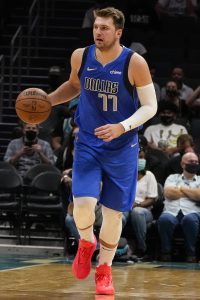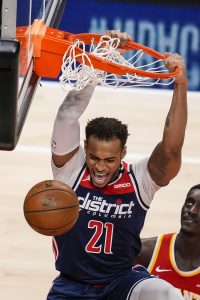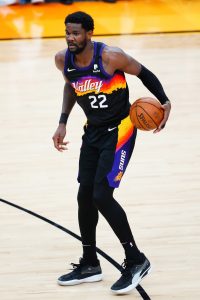The NBA’s annual deadline for rookie scale contract extensions passed on Monday, officially bringing a record-setting extension period to an end. In total, 11 players eligible for rookie scale extensions signed new contracts this year, which is a new record, according to ESPN’s Bobby Marks. Those deals were worth in excess of $1.1 billion, also a record, Marks adds.
We’ve seen an uptick in rookie scale extensions in recent years, but 2021 still represents an impressive high water-mark, narrowly edging out the 10 rookie scale extensions that were completed a year ago. Prior to 2020, the last time as many as 10 rookie scale extensions were completed in a single league year was back in 2006, when players like LeBron James, Carmelo Anthony, Dwyane Wade, and Chris Bosh were signing their second NBA contracts.
Here’s a breakdown of the 11 rookie scale extensions signed before this year’s deadline, sorted by total value. In cases where we haven’t yet seen the official contract terms for the extension, we’re basing our figures on the latest reports and will update these numbers as necessary. These deals will go into effect beginning in 2022/23:
 Luka Doncic (Mavericks): Five years, maximum salary (story). Projected value of $207,060,000. Includes fifth-year player option and 15% trade kicker.
Luka Doncic (Mavericks): Five years, maximum salary (story). Projected value of $207,060,000. Includes fifth-year player option and 15% trade kicker.- Trae Young (Hawks): Five years, maximum salary (story). Projected value of $172,500,000. Projected value can increase to $207,060,000 if Young earns All-NBA honors in 2022. Includes fifth-year player option and 15% trade kicker.
- Shai Gilgeous-Alexander (Thunder): Five years, maximum salary (story). Projected value of $172,500,000. Projected value can increase to $207,060,000 if Gilgeous-Alexander earns All-NBA honors in 2022. Includes 15% trade kicker.
- Michael Porter Jr. (Nuggets): Five years, maximum salary (story). Projected value of $172,500,000. Projected value can increase to $193,256,000 or $207,060,000 if Porter earns All-NBA honors in 2022. Includes partial guarantee ($12MM) in fifth year.
- Jaren Jackson Jr. (Grizzlies): Four years, $104,720,000 (story). Includes Exhibit 3 injury protection related to Jackson’s left knee.
- Mikal Bridges (Suns): Four years, $90,000,000 (story).
- Kevin Huerter (Hawks): Four years, $65,000,000 (story).
- Wendell Carter Jr. (Magic): Four years, $50,000,000 (story).
- Robert Williams (Celtics): Four years, $48,000,000 (base value) (story). Includes $6MM in incentives.
- Landry Shamet (Suns): Four years, $42,500,000 (story). Includes non-guaranteed third year and fourth-year team option.
- Grayson Allen (Bucks): Two years, $17,000,000 (base value) (story). Includes $2.55MM in incentives.
Some of these extensions were no-brainers — there was never any doubt that Doncic or Young were going to get maximum-salary offers as soon as possible, for instance. Of the four maximum-salary deals, Porter’s was the most fascinating, given his injury history and the fact that the Nuggets already had two max players (Nikola Jokic and Jamal Murray) on their books.
Porter showed last season that he’s rapidly becoming one of the NBA’s most talented scorers, so it made sense for Denver to lock him up. It also made sense for the team to protect itself a little, which it did by making the fifth year of the contract partially guaranteed. If Porter makes an All-NBA team or becomes a two-time All-Star, that fifth year will become fully guaranteed, which would be a win-win for player and team.
The seven non-max extensions are all interesting for their own reasons. The Grizzlies and Celtics, for example, bet heavily on players who have had some trouble staying in the court during their first three NBA seasons due to injury issues. If Jackson and Williams can stay healthy going forward, those deals should look pretty team-friendly.
Jackson’s contract does include some protection, but only if he suffers a serious left knee injury, and Memphis would have to waive him in that scenario in order to actually realize any savings. That’s not an outcome either side wants.
Shamet and Allen signed their new deals without having played in even a single regular season game for the Suns or Bucks, respectively. That’s a little unusual, but not at all unprecedented — Luke Kennard and the Clippers took the same path in 2020, and Taurean Prince and the Nets did so in 2019.
The Magic at least got a brief look at Carter last season before committing $50MM to him. It’s the third rookie scale extension Orlando has completed in the last two years, as Carter joins Markelle Fultz and Jonathan Isaac. The team has shown a somewhat surprising willingness to commit long-term to a group of core players that have yet to all play together.
Finally, the Suns‘ deal with Bridges and the Hawks‘ agreement with Huerter have some similarities — both Bridges and Huerter are reliable role players on last year’s most surprising contenders who are getting rewarded with long-term investments.
Both look like fair deals, but it will be interesting to see whether there’s any ripple effect on other players. Is Phoenix still comfortable awarding big money to Deandre Ayton next year with lucrative new deals for Bridges and Shamet now in the books? And how will the Huerter extension impact the odds of the Hawks also extending De’Andre Hunter and/or Cam Reddish in 2022?
While 11 players signed rookie scale extensions, that leaves 12 players who were eligible for a new deal and didn’t get one (a 13th, Chandler Hutchison, was waived by the Spurs early in the offseason). Here’s the list of those players, who are now eligible to become restricted free agents during the 2022 offseason, assuming they finish their current contracts:
Ayton is the most notable name on this list, and we covered his situation in more depth in a pair of stories on Monday. He was reportedly seeking a maximum-salary extension that the Suns were unwilling to offer, so he’s headed for restricted free agency in 2022.
There aren’t many teams projected to have cap room in 2022, but Ayton should be one of the top three or four free agents on the market and would appeal to a wide range of teams due to his age and upside. If he has a strong season, he may still get that max deal he desires.
Of course, it’s worth noting that a max contract could look quite different if it comes in an offer sheet from another team rather than in an offer directly from the Suns. Based on current projections, a rival suitor could offer about $128MM over four years, while Phoenix could give Ayton in excess of $172MM over five. The Suns may be more comfortable matching an offer sheet, but it could include unfavorable terms, such as a fourth-year player option and/or a 15% trade kicker.
Bridges, DiVincenzo, Sexton, and Walker were some of the more intriguing extension candidates in this group who didn’t end up getting new deals and are now on track for restricted free agency next summer. I’d consider Bridges and Walker pretty good bets to stick with their current teams; DiVincenzo’s and Sexton’s futures are less clear. The Bucks will be in the tax and may not want to give DiVincenzo a big raise after securing Allen, while Sexton’s name popped up in some trade rumors over the summer.
The rest of these players weren’t serious extension candidates. Some – including Bamba, Knox, and Okogie – appear unlikely to even receive qualifying offers next offseason unless they show a lot more in 2021/22 than they have in their first three NBA seasons.
 “We’re very excited to extend Daniel’s contract and continue to see him develop within our system after his athleticism on both ends of the floor made such an immediate impact for us last season,” GM Tommy Sheppard said in a statement. “We are confident that he has the character and drive to keep working hard to improve his overall game and become an even bigger part of what we are building with our team.”
“We’re very excited to extend Daniel’s contract and continue to see him develop within our system after his athleticism on both ends of the floor made such an immediate impact for us last season,” GM Tommy Sheppard said in a statement. “We are confident that he has the character and drive to keep working hard to improve his overall game and become an even bigger part of what we are building with our team.”
